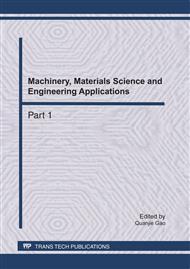[1]
H.I. Connacher, S. Jayaram, K.W. Lyons: Virtual Assembly using Virtual Reality Techniques. Computer-Aided Design, Vol. 29 (1997) No. 8, pp.575-584.
DOI: 10.1016/s0010-4485(96)00094-2
Google Scholar
[2]
Gao Zhan, Zhang Shuyou: An Allocation and Motion Navigator in Virtual Assembly Environment. China Mechanical Engineering, Vol. 13 (2002) No. 11, pp.901-904. (in Chinese).
Google Scholar
[3]
Yang Rundang, Wu Dianliang: Research on Constraint-Based Virtual Assembly Technologies. Computer Integrated Manufacturing System, Vol. 12 (2006) No. 3, pp.413-419. (in Chinese).
Google Scholar
[4]
Kockara, S. Hallic, T. Iqbal: Collision Detection: A Survey. Proc. International Conference on Systems, Man and Cybernetics (Canada, 2007). pp.4046-4051.
Google Scholar
[5]
Cheng Cheng: Construction of Perception Mechanism in Virtual Assembly. Journal of Software, Vol. 13 (2002) No. 12, pp.2324-2330. (in Chinese).
Google Scholar
[6]
Cheng Cheng: Research on Construction of Mating Perception in Virtual Assembly. Journal of Computer Research and Development, Vol. 39 (2002) No. 10, pp.1331-1336. (in Chinese).
Google Scholar
[7]
C. Cheng, Z.L. Xu: Semantic Space Construction for Virtual Assembly. Proc. International Conference on Computer Science and Software Engineering (2008). Vol. 2, pp.1110-1113.
Google Scholar
[8]
H. Wang: Assembly planning based on semantic modeling approach. Computers in Industry, Vol. 58 (2007) No. 3, pp.227-239.
Google Scholar
[9]
Liu Zhenyu, Tan Jianrong, Zhang Shuyou: Research of Motion Guidance in Virtual Assembly Based on Semantics Recognition. Journal of Software, Vol. 13 (2002) No. 3, pp.382-389. (in Chinese).
Google Scholar
[10]
Shao Xiaodong, Yin Lei, Lu Yuan: Rapid Assembling Approach Based on Assembly Features. Computer Integrated Manufacturing Systems, Vol. 13 (2007) No. 11. (in Chinese).
Google Scholar
[11]
Shen Mei, Lei Zheshu, Zhang Tiechang. Generating Algorithm of Assembly Sequence Based on Assemlby-Feature. Journal of Engineering Graphics, (2001) No. 3. (in Chinese).
Google Scholar
[12]
Tang Lin, Zhang Mengchun. Research on Automatic Assembly Based on Assembly Feature Modules. Machinery Design and Manufacture, (2007) No. 10. (in Chinese).
Google Scholar
[13]
Montreal Que. Feature-based Assembly Model and Multi-Agents System Structure for Computer-aided Assembly. Proc. International Symposium on Assembly and Task Planning (1999).
DOI: 10.1109/isatp.1999.782927
Google Scholar
[14]
Jin Yu, Hou Wenjun, Yang Fuxing. Context Perception Mechanism in Virtual Assembly Environment Based on the Multi-Agent. Journal of Donghua University, Vol. 36 (2010) No. 4, pp.366-370. (In Chinese).
Google Scholar
[15]
Tiemeng Li, Wenjun Hou, Hao Pan. Put Context-Aware in Virtual Assembly: a Study of Ontology-Based Architecture and an Arithmetic. Proc. International Conference on Joint Conference on Pervasive Computing (Taiwan, China, 2009) Vol. 1, pp.503-506.
DOI: 10.1109/jcpc.2009.5420134
Google Scholar


